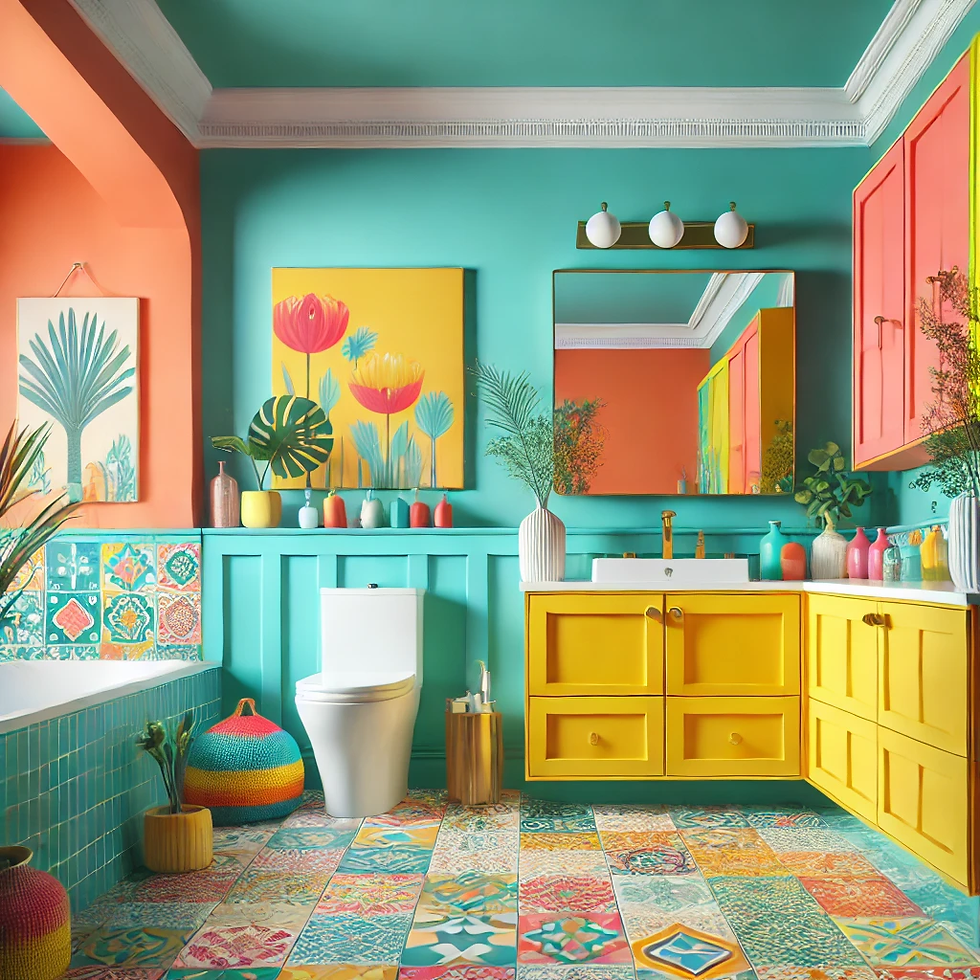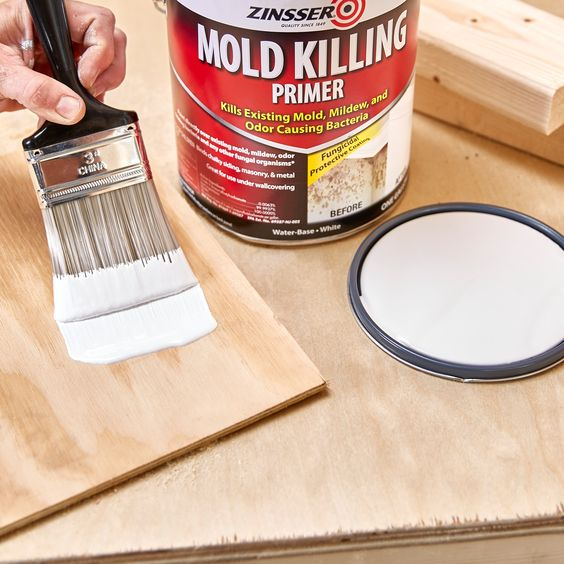What Kind of Paint for Bathroom?
- Staff Desk
- Oct 4, 2024
- 6 min read
Updated: Oct 8, 2024
Painting a bathroom can make a huge difference in how the space looks and feels. Choosing the right type of paint is especially important in a bathroom because of its unique environment – it's humid, often wet, and needs a paint that can withstand those conditions. In this blog, we’ll guide you through what kind of paint is best for a bathroom, including different types of paint, their finishes, and tips to make sure your bathroom paint lasts a long time.
Approximately 40-50% of homeowners prefer neutral tones for their bathrooms, including shades like whites, grays, and beiges.
Blues remain a popular choice for bathroom spaces, with surveys showing that around 20-30% of homeowners select shades of blue
About 15% of homeowners lean towards these warmer hues for a more inviting and cozy atmosphere.
Satin is one of the most popular choices for bathroom walls, with about 35-40% of homeowners choosing it due to its durability and slight sheen.
Why Choosing the Right Paint Matters
Bathrooms have more moisture and humidity than other parts of your home. The constant steam from showers and baths, combined with water splashes, can quickly damage paint that isn't designed to handle these conditions. The wrong kind of paint can peel, crack, or allow mold and mildew to grow. That's why it’s important to choose the right paint that will protect your bathroom walls and stay looking beautiful over time.
Types of Paint for Bathrooms
There are a few different types of paint you can use in your bathroom, and each has its advantages. The main types are latex paint, acrylic paint, and oil-based paint.
Latex Paint
Water-Based: Latex paint is water-based, making it easy to use and clean up. It's also more environmentally friendly compared to oil-based paint.
Durable: Latex paint is durable and holds up well to moisture, especially if you choose the right finish (like semi-gloss).
Low Odor: It has a lower odor compared to oil-based paints, making it easier to work with inside your home.
Acrylic Paint
Moisture Resistant: Acrylic paint is highly resistant to moisture, making it a great choice for a bathroom. It offers good adhesion and resists peeling even in high humidity.
Easy Application: Acrylic paint is easy to apply, and it dries quickly.
Oil-Based Paint
Durable: Oil-based paint is known for its durability and ability to create a hard, moisture-resistant surface.
Longer Drying Time: One downside is that oil-based paint takes longer to dry and has strong fumes. It’s less commonly used today due to the strong odor and environmental concerns.
The Best Finishes for Bathroom Paint
The finish of the paint is just as important as the type of paint you choose. The finish affects how well the paint holds up to moisture, how easy it is to clean, and how it looks on the walls.
Semi-Gloss Finish
Moisture Resistance: Semi-gloss is the most common finish for bathroom walls because it is highly resistant to moisture. The slight sheen helps to repel water and makes it easy to wipe down.
Durable: Semi-gloss finishes are durable, which means they can handle cleaning without getting damaged.
Satin Finish
Slight Sheen: Satin has a slight sheen that makes it somewhat resistant to moisture while providing a soft look. It’s a good option for people who don’t like the shine of semi-gloss but still want some moisture resistance.
Great Balance: Satin finishes strike a good balance between being moisture-resistant and easy to clean. It works well on bathroom walls, especially in powder rooms where moisture isn't as constant.
Gloss Finish
High Shine: Gloss paint has a very shiny finish and is the most moisture-resistant option. It’s great for high-moisture areas, but its shine can highlight imperfections in the wall.
Best for Trims and Molding: Gloss finishes are often used on trim, molding, and cabinets in bathrooms rather than on the walls.
Eggshell or Matte Finish
Not Ideal for High Moisture: Eggshell or matte finishes are not recommended for bathrooms because they absorb moisture rather than repel it. These finishes are more prone to showing watermarks and mildew growth.
Use in Low-Moisture Areas: If you’re painting a half-bath or powder room where there’s no shower, eggshell may be an option for a softer look.
Mold- and Mildew-Resistant Paints
Bathrooms are prone to mold and mildew because of the constant moisture. Thankfully, some paints are specifically designed to resist mold and mildew. These paints have special additives that help prevent the growth of mold, keeping your bathroom cleaner and healthier. If your bathroom doesn’t have great ventilation, using mold-resistant paint is especially important.
Look for paint labeled as “bathroom paint” or “kitchen and bath paint.” These products are formulated to withstand high humidity and resist mold and mildew growth. It’s also a good idea to prime your walls before painting with a mold-resistant primer for added protection.
Preparing the Bathroom Walls for Painting
Painting a bathroom isn’t just about choosing the right paint – preparation is key to making sure your paint job lasts. Here are some steps you should take before painting your bathroom:
Clean the Walls: Make sure your walls are clean before painting. Use soap and water to remove any dirt or grime. You can also use a mixture of water and vinegar to remove mold or mildew. Let the walls dry completely before moving on to the next step.
Repair Any Damage: Bathrooms can have cracked or peeling paint due to moisture. Scrape off any peeling paint, and use a filler to repair any cracks or holes. Sand the surface smooth after the filler dries.
Prime the Walls: Priming is an important step, especially in a bathroom. A good primer will help the paint adhere better and provide a good base for the paint. Choose a primer that is mold- and mildew-resistant for the best results.
Tape and Protect: Tape off any areas you don’t want to paint, such as the edges around the ceiling, trim, or fixtures. Use drop cloths to protect the floor and countertops.
Tips for Painting a Bathroom
Use a Brush and Roller: Use a brush for cutting in around the edges and corners, and use a roller for the larger areas of the wall. A roller with a short nap is best for smooth surfaces like bathroom walls.
Apply Two Coats: It’s usually best to apply two coats of paint in a bathroom. The first coat will provide a good base, and the second coat will give you a smooth, even finish.
Ventilation: Make sure your bathroom is well-ventilated when you’re painting. Open windows or use an exhaust fan to help the paint dry faster and reduce fumes. Good ventilation will also help prevent mold and mildew from growing.
Maintaining Painted Bathroom Walls
Once you’ve painted your bathroom, you want to make sure it stays looking good for as long as possible. Here are some maintenance tips:
Reduce Moisture: Use an exhaust fan or open a window when you take a shower or bath to reduce moisture levels in the bathroom. This will help prevent mold growth and keep the paint in good condition.
Clean Regularly: Wipe down the walls regularly to prevent soap scum, watermarks, or mildew from building up. Use a soft cloth and mild soap. Avoid using harsh chemicals that can damage the paint.
Touch Up as Needed: Over time, your bathroom paint may need touch-ups. Keep a small amount of leftover paint to cover any chips or scratches that may occur.
Understanding Matte, Flat, and Eggshell Finishes for Bathrooms
When it comes to painting bathrooms, many professional painters advise against using flat, matte, and eggshell finishes due to their susceptibility to mildew in high-humidity environments and difficulty in cleaning. However, advances in paint technology have led to the creation of mildew-resistant options, allowing for a luxurious and soft look in your bathroom.
Here’s a closer look at these finishes and some products designed specifically for bathroom use:
Matte and Flat Finishes
Pros:
Offers a soft and luxurious look.
Some products are durable and mildew-resistant.
Cons:
Susceptible to moisture.
May peel if not properly primed.
Not all products are mildew-resistant.
Recommended Products:
Benjamin Moore Aura Bath and Spa – Matte: Designed for high humidity, providing a durable matte finish.
BEHR Ultra Scuff Defense – Flat: A flat paint that offers stain-blocking features while resisting mildew.
Zinsser Interior Perma White – Eggshell: An eggshell finish that provides a washable surface and is resistant to mold and mildew.
Eggshell Finish
Eggshell is often considered synonymous with satin, but it is slightly less suitable for bathrooms. It shares similar qualities with flat and matte paints but offers a bit more washability.
Maintenance Tips
After these low-sheen paints cure, you can clean your bathroom walls using soap, water, and a smooth cloth, making them more manageable than traditional flat paints.
Conclusion
Choosing the right kind of paint for your bathroom is essential for a lasting and beautiful finish. Latex and acrylic paints are the best options for bathroom walls, and it’s important to select the right finish – semi-gloss or satin – for durability and moisture resistance. Gloss paint is best for trim and molding, while matte finishes should generally be avoided in high-moisture areas.
Using mold- and mildew-resistant paint will help keep your bathroom looking fresh and clean, and proper preparation and maintenance will ensure that your paint job lasts for many years. By following these tips, you can create a bathroom that is not only stylish but also able to withstand the unique conditions of this important space in your home.




